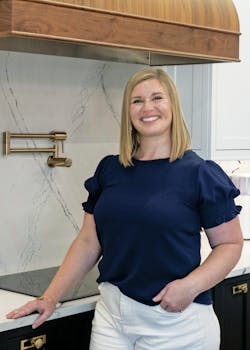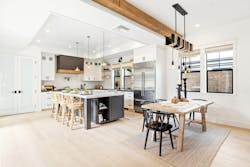Your design build business was growing, but now it’s reached capacity and appears to have stalled. What should you do next? Hire salespeople? Spend more on marketing? Expand services? Risk investing money you haven’t made yet?
“Remodeling businesses have evolved,” says Mark Richardson, an industry advisor, who helps remodeling companies grow to the next level. “There’s no playbook. You grow to $1 or $2 million and realize you have a business. Now, how can you move forward and grow healthy and profitable? Everyone has a slightly different story.”
That story, by necessity, is a tale of ingenuity, vision, and commitment to excellence. This is because design build’s long sales cycle and deeply custom projects make for an unwieldy business model that’s hard to scale. Hard, but not impossible. Here, we chart the path of five companies who have leveled up on growth.
Learning from Mistakes, Evolving to Design Build
Philadelphia
2023 Reported Revenue: $6M
Will Giesey learned something as a teen in summer camp that became his guiding philosophy: “Work is love made visible.”
He started as a sculptor, acquired his MBA, and owned several businesses before founding Bellweather Design Build in 2002, but it wasn’t until 2011 that he embraced design build.
Early on, like many entrepreneurs, Giesey found it easy to get pulled in too many different directions. “The goal for me was to not wear too many hats,” he says.
At about the $3 million mark, Giesey realized he needed to become a better manager to more effectively run projects. To accomplish that, he joined Remodelers Advantage, the National Association of the Remodeling Industry, and the Professional Remodeling Organization.
“Joining Remodelers Advantage was a big shift for us in terms of understanding what a builder’s business should look like,” he recalls. “Things like how to make sure you’re building in the margin, turning the right people away, protecting your staff, and getting out of your own way in terms of ego. I also had mentors in that community who I kept hammering with questions as I tried to model our approach after what was proven.”
Business-wise, Bellweather hit a plateau for several years around $3 million. Giesey had one designer and two project managers, plus him and a business partner. They found they didn’t have the design capacity to help people in need of a full set of plans, and they would occasionally bring in an architect.
“We weren’t doing many jobs that were large enough for architects,” Giesey says. “It was sort of an in-between stage where we needed the confidence to charge enough for design, and we were sort of short cycling and not giving enough effort to the design side.”
He also found it hard to take care of sales and oversee design and felt the company needed to specialize.
“Around $5 million, we hired five salespeople and fired them all within six months,” he says. “It was a disaster. They didn’t follow directions and we realized we needed people who could follow a process and do something repeatable.”
Giesey discovered that it became very difficult to lead the company effectively, handle sales, and keep an eye on day-to-day operations at that revenue level. “I think that’s probably the growth stage that most people can’t get past,” he says. Hiring the right team members was a learning process.
“We started out with people who were talented, but a little crazy, and once we understood the DISC profile, we moved toward people who were SC, meaning that they were compliant and followed process and wanted to do it right, rather than people who just brought a huge personality and just did it by force of will,” he says.
Giesey found that separating sales and design worked better for the company, and they hired specialists who could sell and specialists who could design. The design department has three designers, a drafts person, two estimators, and two logistics coordinators. The sales department has three salespeople, including Giesey, and an intake coordinator/marketing professional. This structure has been working over the past four years.
Currently, Bellweather’s average job is around $425,000, and they’re aiming for $500,000. “At that level, you can bring in specialists in every single aspect—in the development and in the execution,” Giesey says.
Re-Branding, Training Rookies, & Involving Trade Partners in the Process
RIKB Design Build / Warwick, R.I.
2023 Reported Revenue: $8.4M
In 2018, Rhode Island Kitchen and Bath’s annual sales were under $4 million. In 2023, the company reported nearly $8.5 million. Certainly, COVID played a role in that growth, but there were other key factors.
“We found that having kitchen and bath in the name wasn’t clear for many people, and a lot of them thought we sold plumbing supplies,” says Kingsley Catalucci, a design consultant. “We rebranded to RIKB and created a more modern logo. Our business model didn’t change, but it helped us stand out and attract the clients we were looking for.”
There are five design consultants on the RIKB team, and they also serve as salespeople. Each has been trained in design and is the first point of contact as they guide clients through selections.
RIKB also has support staff who focus on technical drawings, cabinetry, and assisting the lead designers throughout the selection process. For 3D modeling and drafting, they use Chief Architect.
Catalucci attributes the company’s success to its owners, Tanya Donahue and Michael Donahue Jr., who acquired the firm in 2018 and prioritize investing in people and training them for success.
The leaders encourage new employees to accompany veterans to industry events, so they can see the bigger picture and understand their value on the team.
To ensure that training is well-rounded, rookies will shadow a veteran for—depending on their experience—six months to a year or longer before they’re on the sales floor.
“We want to build a solid, competent team, so no one’s nervous that they haven’t been trained properly,” Catalucci says.
“Another aspect of success here is how departments communicate with each other. Even beyond our staff, we involve our trade partners—plumbers, electricians, etc.—in the design process so we can make proper assessments.”
Here’s how that works: About halfway through the design development stage, RIKB schedules a site visit with the client that includes a member of the production department and the trade partners.
This allows the plumber, electrician, demo crew, and flooring professional to make their own assessments of the existing layout by seeing it physically, so they can accurately quantify their numbers.
“It can save a lot of heartache down the road,” Catalucci says.
RIKB’s marketing has shifted away from more traditional campaigns aimed at Baby Boomers to an increased social media presence targeting Gen X and Millennials. These efforts have brought in bigger jobs through a mix of kitchen, bathroom, and multi-room projects.
The company also hosts monthly seminars at its design center, where they have a collection of samples curated from local vendors they use for tile, countertops, cabinetry, flooring samples, and down to grout colors.
Over the past four years, Nicholas Design Build has seen its average job grow from $50,000 to $75,000 to more than $200,000. Before 2020, the company had a staff of about six. Now it’s more than 30, including project managers and in-house carpenters.
At Nicholas, designers sell. However, in 2022, they tried a different model. “There was a pain point when we tried separating sales and designers,” says Jessica Seljan, sales & design manager. “That works for some companies, but it didn’t for us. We had lost the relational aspects of what people want, so we went back to designer salespeople.”
Do they look for designers who can sell or salespeople who can design?
“We’re still figuring it out,” Seljan says. “I think there’s a notion in this industry where it’s kind of a unicorn position because designers are frequently kind of shy and like to be behind a computer, and then there are some who are more showy and say, ‘Hey, let’s do it this way.’”
When they focused on hiring salespeople with experience in other industries, they lost the personable part of design build. “If you take away that relational aspect, I think it takes away some of the trust,” Seljan says.
Consequently, Nicholas has refocused on people with high-level design capabilities who can lean into that relational side. “We’re not looking for a quick transaction,” Seljan says. “This could be a four- or six-month experience, and for some large home remodels, it could be a year or more.”
Nicholas has a project developer for cold calls, and they serve as the first step of the sales process. Then, once a client signs the initial agreement, they move forward with a designer to “build that trust and go the rest of the journey.”
As for training new designers to develop their sales abilities, there’s no one way. Sometimes a homeowner requests to speak with a lead designer and the newer designer will have the opportunity to shadow them. Sometimes, a design coordinator can go from quoting materials and doing design work with Chief Architect and ease into designing and soft sell conversations. Eventually they will train up to where they’re running their own site visits.
One of the keys to Nicholas’ success is the company’s focus on viewing the client as a partner in the project. “We’ve found the vast majority of homeowners feel invested in the project and want someone to help guide and educate them more than anything,” Seljan says.
Jackson Design & Remodeling looks for ways to stand out from the competition and to that end, the company recently held a 35th anniversary celebration and client appreciation party at the San Diego Yacht Club.
Project Manager Jim Groen has been with Jackson for the past 16 years. “Our sweet spot is whole home conversions,” he says. “We want to make the home customized and special for the owner.”
One key to Jackson’s success lies in the company’s monthly seminars, which account for 65% of business, Groen says. Most of the attendees are couples, and many respond from Jackson’s website and presence on social media. Jackson typically hosts 40 to 60 attendees a month and provides a catered lunch, gift bags, and raffle tickets for dinners at popular San Diego restaurants.
“We ask them to arrive 15 minutes before the presentation, so they can relax, look at the showroom, and get comfortable,” Groen says.
Jackson kicks off the seminar with a video of testimonials from satisfied clients. Then, over the next hour or so, team members provide general education about what remodeling is all about, what to look for in a contractor, and what to expect for your project.
“After that, we break for lunch, and they can get more hors d’oeuvres, stretch their legs, and look around the showroom,” Groen explains. “Then in the second half, we show different projects we’ve completed—before and after—and talk about what our clients were asking for and how we responded.”
Afterward, if someone is interested in having Jackson come to their home, they offer an obligation-free consultation. Then, if the homeowner decides they want to move forward with the first step of the design process, the company offers a 50% reduction in the cost of the first step.
“This is a thank you and a way of making it easier for them to move forward,” Groen says.
The first step of the design process includes drafting and measuring the home with a 3D camera. An interior designer, someone in the architecture department, and the project director visit the home together.
The team conducts an in-depth interview in the home and asks the client specific questions about their vision, pain points, and the focus of the project. “Then we create inspiration boards based on the aesthetic and the imagery they discussed. The architecture department puts together three different concepts, kind of a good, better, best, or least expensive to the most expensive or embellished,” explains Groen.
Depending on the type of project, this first step usually costs $2,000-$20,000.
At the most recent seminar, there were 20 couples (40 people in all), and the gathering generated 13 opportunities for further in-home discussions.
Currently, Jackson has a staff of approximately 50 and completes projects in the $200,000 to $3 million range, with the average being about $500,000.
Recruiting, Training, & the Power of 7²
Mosby Building Arts / St. Louis, Mo.
2023 Reported Revenue: $23.6M
For a small business to scale, Mark McClanahan, president of Mosby Building Arts, says it needs to transition from personality-driven to process-driven. The company developed its own software in 2011 that’s become a full-blown ERP (minus the accounting system) to handle processes. But that was only a piece of the puzzle.
“We had been documenting for years, but until we got really good at training and holding people accountable, we just weren’t that successful,” McClanahan says. “I learned a valuable lesson from Brian Gottlieb, a business leader, who said [his company] wasn’t a construction company, they were a training company, and that’s what we try to do.”
McClanahan says the more they concentrate on training, the better off they are. That’s where the lesson of “7²” enters. Seven-squared means that to learn something new, the average person needs to hear it seven times at a seventh-grade level. “If we develop a process and want to make it scalable, we try to present it in different kinds of ways to make sure to do the right type of training and that it sticks,” McClanahan says. “That’s the responsibility of leadership, and we struggled when hiring lots of people fast before figuring that out.”
In the past three years, Mosby created two new positions that made a difference: a field development manager to onboard new talent, which can be a four- to six-week process, and a full-time recruiter.
Key metrics include 55% revenue from design build, 20% from semi-custom kitchens and baths, 20% from exteriors, and 5% from small projects. Strategic partnerships with banks and service finance companies contributed significantly to business growth.
What Will Your Story Be?
Scaling your business needs to be customized for you—like a remodel project. No two are exactly alike. However, some common themes emerged: thoroughly train your staff, constant communication between departments and trades people is key, let your staff know they are valued, and identify the design/sales model that works best for you. Maybe it’s time to turn the page for a new chapter in your story.
About the Author
Phillip Vaughn
Phillip Vaughn is a freelance writer living in New York City.








